it’s the best time of the year
A Holly Jolly Christmas kept getting stuck in my head, and for whatever reason I kept swapping out the words with slushy wushy instead. So, here it is, perhaps the first example of “slushposting” on the internet. It’s a slushy, wushy Christmas, and the streets are covered in slush; the air is thick with haze, but we don’t mind the fuss…1
Anyhow, I wrote this throughout December ‘22, and it was a goal of mine to focus exclusively on physicals that I owned. I fell short for one release, but I mostly stuck to it!
But, what the heck is ‘slush’ anyways?
Slushwave is what you get when you grab all of your effects VSTs and jam ’em together on one track. Or thereabouts. But more accurately, the style involves turning your track into a slowly-swirling wash of phased and reverbed sound. In a sense, it’s what would be called “overprocessing” in the mainstream industry. Or at least, it was until things like “Kid A” came out around 2000, upping the ante on how far you could theoretically go with dropping processing into your mix.
It’s actually quite fun to produce this stuff, too. It’ll have you digging through your modulation and time-domain plugins for hours, pushing the line out on “how far” you might go with slathering on the processing. When you get to the point where things start to sound like that moment at the dentist’s JUST BEFORE the anesthesia kicks in and you can’t recall anything after that point…that’s when you’ve got some quality slush happening.
Definition via u/Lugia909
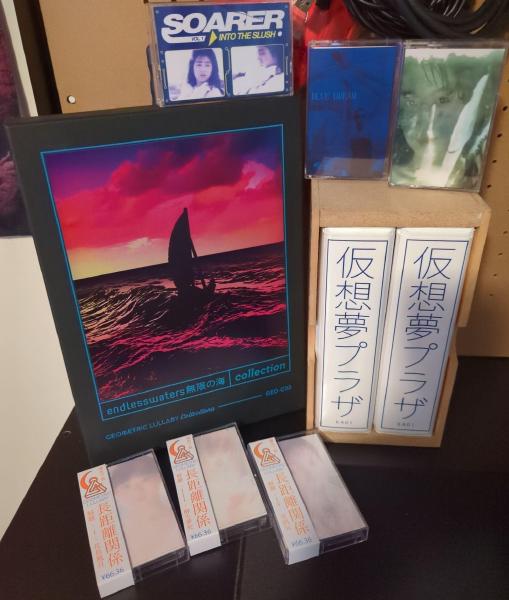
Virtual Dream Plaza
I somehow managed to nab one of the apparent 25 copies of the gorgeous box set for the 2015 Virtual Dream Plaza compilation, and the seller and only previous owner tells me that I’m the first to play the tapes themselves. I wasn’t considering the “purity” of the cassettes when I learned of this fact, but it’s crossed my mind after seeing the perfectly clear shell on each of the 16 tapes. There’s also an emergent and beautiful symmetry, where the music on both sides of every cassette almost exactly matches the length of the tape, with little to no excess; for non-cassette enthusiasts, this is a rarity since it’s practically inevitable that one side will be longer than the other, but the artist went out of their way make this happen – for example, Dream Girl’s 31 minute 36 second runtime is coupled with Telepathy Lovers’ 31 minute 30 second runtime, leaving just 6 seconds of lead-out on the B-side.
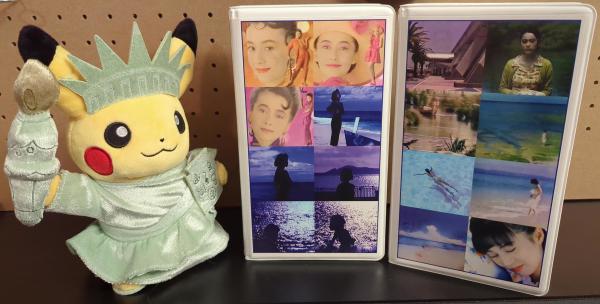
Discussing the project is somewhat difficult, given its monstrous total runtime of just shy of 17 hours, and the fact that even listening through the project without frequently pausing and pondering each track can end up with the entire experience feeling somewhat ephemeral. On the one hand, the listener gets the opportunity to really sit with the music, as each track is over half an hour long and repeats, morphs, and changes throughout; on the other hand, it’s trivial to get lost in the fog of the sheer size of the project when there’s 32 of these half-hour tracks. Though I have mostly been abstaining from taking notes while listening through, the track I Need You, the project’s half-way point, really caught my ear as a track I could put on repeat several times and feel satisfied by. Prior to this, all of the tracks containing vocals really stood out to me, though the instrumental-only tracks have been really strong as well. Almost none of the tracks feels out of place or unwelcome to me personally, but Cognitive Reconstruction and Rift seem to receive a bit of dislike around the internet.
I wanted to take a peek at the comments on the Vapor Memory YouTube uploads, as well as on the project’s RateYourMusic page. On YouTube, “an elevator that doesn’t cease to ascend,” “one of the most powerful ambient works to date,” “music that doesn’t tell you what to feel,” and the humorous “the final boss of vaporwave.” Additionally, there are many comments that point out particular tracks as their favorite, without any real majority vote; one comment that caught my eye was a listener professing their love for one track in particular, and I read it just before that track came on and I really didn’t care for it as much as they did. It’s also an interesting experience to look at the view count on each individual track; it’s immediately apparent that people’s preferences are all over the place. I really loved I Need You, for example, but its view count comes off as rather low, which implies that I’m in the minority.
Moving on to RateYourMusic, I really enjoyed merton’s review from 6/24/22 on the track Waiting For You, arguing that the genre is less “vaporwave” and more “exotica,” explaining the idea of the genre as “1950s Americans want[ing] to bring the wonder and magic of far-off locations into their midwestern living rooms.” The review continues on and refers to the music as “music as sight-seeing” and ultimately “music as dream” or, “music that takes you to a place that does not exist and cannot exist.” Outside of merton’s review, a common comment I see are the reviewers saying that the tracks consistently make great use of their time – which is saying a lot given each track’s length.
I shared with the prior owner that on the day of the box set’s arrival, I had a lot of work to do that night and I intended to use Virtual Dream Plaza as a sort-of calming soundtrack to my evening. He used the word “meditative” to describe the music, and stated that although it’s “good” for the purpose I had laid out, it really rewards more intentful listens. I’ve been listening with this idea in the back of my head, sometimes stopping what I’m doing to really soak in the music; it’s happened on numerous occasions where the tape clicks over to the next track and I think, “that was a half-hour?” Getting lost in the Dream seems to come naturally.
OpenAI’s ChatGPT launched around the time I reached the half-way point of my first listen, and I gave it a prompt and asked it to write me a poem about the project. I liked it enough to share –
In the Virtual Dream Plaza,
Where the music never ends,
A compilation was born,
A journey through a dreamy land.
Slushy, hazy, ephemeral,
The songs drift like a fog,
Capturing the heart and soul,
In a swirling, slushy bog.
From the first note to the last,
We lose ourselves in the haze,
Our senses dulled and numbed,
As we drift in a slushy daze.
But even as the music fades,
And our minds return to reality,
We carry with us the memory,
Of the Virtual Dream Plaza’s melody.
S O A R E R - Into the Slush vol 1
I was looking for a shorter album to dive into after the monster that was Virtual Dream Plaza, and I settled on the single volume of SOARER’s Into the Slush vol. 1. Calling it “shorter” is a disservice; it’s shorter relative to VDP, but it’s a solid 50-minute release, and I always feel like I’m getting my money’s worth on 50-minute tapes. This was released via No Problema Tapes, which has a pretty clear standard for tape designs, so anyone who knows No Problema already has an idea of what the design will look like. I’m probably biased since I own the tape, but I think I prefer the tape’s design over the square, digital album cover; additionally, I appreciate what the B-side’s art was trying to accomplish, given that No Problema doesn’t normally do this type of thing, at least from what I’ve seen.
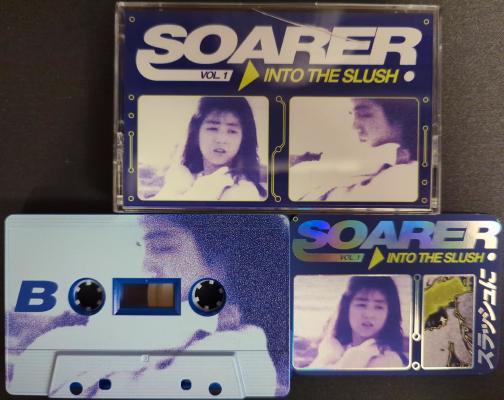
What sticks out to me more than anything in this release is the consistent and creative percussion. Has my ear for slush been tainted by VDP’s extremely long and drawn out samples, with a comparatively minimal amount of percussion? Yeah, maybe, but that doesn’t make the percussion on Into The Slush vol. 1 any less noteworthy. I have to disagree with the highest-voted comment on Rabbithole Club’s YouTube upload of this album, saying “feeling like a drowning [sic] in peace in a pool” – the album is certainly relaxing, but it more-so evokes the type of relaxation that comes from a mellow hip-hop beat, especially on the second track, rather than being completely “drowned” in the slush. In other words, I’d save that type of descriptor for the slush that borders on ambient, rather than this percussion-heavy slush that I can picture an artist like Throwed Genji rhyming over.
The only other SOARER physical I own is the Malls of Lima vol. 3 tape, which may be a close family member to slushwave but it probably isn’t fair to count it. But, maybe if I’m patient enough, SOARER will end up following Into the Slush vol. 1 up with a full 4-volume set! Anyhow, I’m only aware of the artist because of No Problema issuing this tape, and I nabbed Malls of Lima vol. 3 at ECON 3’s tape swap, but the quality of these 2 albums, as well as a sort-of “seal of approval2” from the “king of context3,” 猫 シ Corp., are evidence that I need to keep a closer eye on SOARER’s output.
Nmesh & telepath Path to Eden
What an absolutely wonderful listening experience. The album cover devoid of any other context is enough to know that telepath is probably involved. The color scheme and artwork, both outside and the liner art, are very representative of what you’re getting into and a perfect example to point to when trying to describe to someone why vapor is such a rich macro-genre.
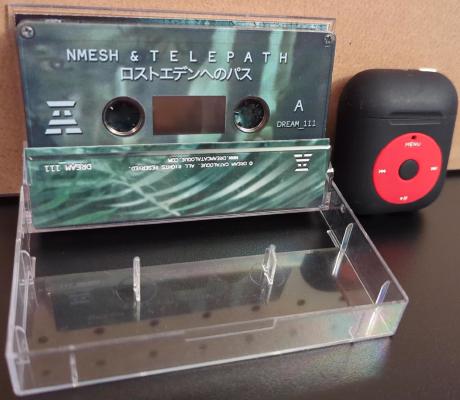
Prior to the vocal samples coming on, it may not even be clear who worked on which side; I’m not even sure if I knew that this was a split, rather than a more collaborative album, until after my first listen. I’m also not sure how much back-and-forth there was between the artists, or perhaps if some or much of the album’s achievement comes from a happy accident, but the album feels very whole, and cohesive; it doesn’t come off as a split for the sake of marketing, as many to me do (especially outside of the vapor space), rather it comes off as the album’s name seems to intend it to: a journey. The structure of the album is supposed to be Nmesh taking the listening through “The Path” on Side A, utilizing every trick in the book to shepherd the listener along, ultimately reaching “Lost Eden” with telepath on Side B.
Side A, “The Path,” is less traditional slushwave, but I look at it as in the same ballpark, evoking many similar feelings and emotions with its slush-like, heavy-handed though surgically tailored use of the effects chain. I likely wouldn’t have included Side A in this list if it was an album by itself, but the full package is greater than the sum of its parts, as great as those parts may be individually, and the full package is “slushy” enough to warrant an exploration during corbin.zip’s Slushy, Wushy Christmas. Through the slush-inspired, cozy but confrontational, damp and chaotic jungle we go, in both a physical and spiritual search for…
Side B, “Lost Eden,” kicks off sounding exactly like a natural extension, or perhaps even closure, to “The Path.” VDP vibes are present to boot before moving more into the slushy, dancey 1980’s-sampling territory on Glowing Eyes. It’s on the verge of turning into a party in Eden, before effortlessly and naturally winding back down to the thick, heavily-processed sounds that create an ambient, relaxing space. The remainder of this project continues this meditative and borderline spiritual vibe, forgoing the more traditional, 80’s-centric telepath sound; some cursory searching tells me that many 80’s samples were used on telepath’s side, regardless of me being aware of them or not while listening.
The Path to Lost Eden paints a complicated and unique picture of Eden, and is yet another reminder of what makes this genre worth exploring on a deeper level; perhaps your everyday top 40’s listener may take issue with this sort of an “alternative,” ambient-heavy concept album, but anyone with an open mind who needs some convincing to take vapor more seriously is apt to have their opinion changed by this album.
Blue Dream
Do you think there’s too much telepath in this list? Well, 猫 シ Corp. isn’t well-known for slushwave, and some newer vapor fans may not even be aware that Blue Dream was originally a split with telepath. Since I’m trying to keep this list exclusive to physicals that I own, and I only own a copy of Blue Dream that does not include telepath’s half, we’ll be focusing on 猫 シ Corp.’s contribution… well, maybe we’ll get a little ideological and argumentative first :)
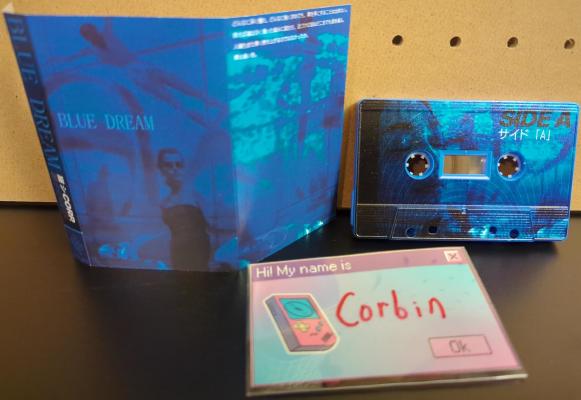
This actually seems to receive a lot of criticism, essentially calling the album an excuse to “rip off” telepath’s style. Reading through the comments from the last couple years on RYM gives an idea of why it’s so disliked, while reading through the much older YouTube comments makes you question if listeners even noticed 猫 シ Corp.’s name on the release.
Well, I noticed! And I’m not a Blue Dream hater! I understand and can frequently empathize with the desire to compare sides in a split, but I feel that a split’s purpose is to become more than the sum of its parts (as I described The Path to Lost Eden). Admittedly, the full Blue Dream split may have missed this mark for me (certainly not for all listeners), but I still don’t think that makes it necessary to argue about which side was better on its own. I would also bet that a lot of this discourse comes from the sort-of “mystery” of telepath deciding to have seemingly nothing to do with his half of Blue Dream, coupled with his overall mystique as an artist, and omnipresent vaporwave legacy. telepath’s half of Blue Dream certainly isn’t a “lost album,” but it toes that line, having never been issued on physical, and being removed in all official capacities at the artist’s request; I think that these facts may contribute to fans becoming more invested in “picking a side” – pun somewhat intended.
I enjoy 猫 シ Corp.’s half of Blue Dream and I pop it in my tape deck with some frequency. Similar to an especially scathing RYM review, very soon after hitting “play” for the first time, I also came to the conclusion that 猫 シ Corp. was setting out to create traditional slushwave, but I don’t consider this to be an inherently bad thing. The review calls it “emulating telepath,” but I’m curious how one could distinguish “emulating telepath” from the entire slushwave genre? Did telepath not invent this genre, and dominate the space, much like Haircuts for Men and barber beats4? It’s a unique experience that should be enjoyed for what it is. I won’t go any deeper in this argument than the following question: the entire “vapor” genre is built on recontextualizing the work of others to create something new; why would the line be drawn at sampling and not also allow for entire subgenres or styles to be explored by other artists in the space?
If it isn’t immediately apparent to any Blue Dream fans, I did not have this album on in the background while writing these first several paragraphs. Why do I think this is obvious? Well, it’s so chilled out and dance-y; great music to bob your head along to; not great music to use as a soundtrack for admittedly nerdy arguments. Sure, the listener is apt to pick up on the similarities to telepath very quickly; but once past that, I’d bet that the average listener is too busy enjoying the ride back to the 1980’s, with hazy, slushy goodness being thrown all over the place, though never reaching the point of becoming overbearing.
What’s the story the split is trying to tell? What about each individual half? What is the artwork trying to make me feel? Well, the artwork is unsettling and somehow both borderline unwelcoming while still being cozy, but let’s just try to nod our heads along and veg-out instead of over-analyzing this great 猫 シ Corp. release. If I’m pressed, a simple interpretation of the album could be the recontextualization of love-centric tracks; sort of a trip back in time to a lost love. Perhaps if you’ve been single for a while and you’ve dreamed of dancing the night away with an old lover, you could call that a Blue Dream…
…but I’m not sure; at least 猫 シ Corp.’s half is too groovy to make me feel Blue – alone or not, I just want to dance! But that may say more about me than the album.
As a final word – please give 猫 シ Corp.’s half a chance instead of listening to the nay-saying reviewers and low RYM ratings. I really enjoy the ride, and I hope you will as well!
endlesswaters collection
I was insistent on owning all of the Geometric Lullaby box sets, and I’ve been incredibly satisfied with them so far. Unfortunately, I do have to view endlesswaters a little differently. To kick off with some positivity, it really is an incredibly unique, consistent, and cohesive listening experience; the album artwork seems to match the sound and feelings conveyed by the music perfectly, and the listener can really get into that “space” by following along with the track names and per-track artwork.
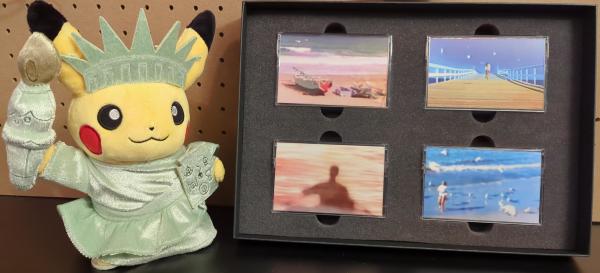
Calling it cohesive is accurate and a statement that I stand by, but where my more negative viewpoint comes into play is as a project, and as a box set listening experience. There just isn’t enough variety between tracks, or between tapes, to warrant scheduling 7 precious hours to listening start-to-finish with any level of intent. I’ve done this twice so far and I’m not looking forward to a third time.
To be more specific: prior to beginning my second listen, I had a memory of listening to all 7 hours when it first arrived and getting sort-of annoyed with the length of the project. But I also remembered enjoying the sound, which seemed to run contrary to finding it overall a bit of a grating experience. So, what gives?
I hit “play” on side A of the first tape and, oh wow. This really does transport me onto that small boat in the rough-but-not-too-rough endless waters, looking out over a permanent sunset with the clouds and sun frozen in position. I usually burn instead of tan but I think the clouds are blocking enough of the sun; the temperature out here seems to be perfect; there may be some level of chaos around me but I just feel comfortable. Wait, why didn’t I enjoy this on my first listen? Maybe I just didn’t have the ear for it?
Then I flip to side B…and on to side C… and before I can even reach side D, I find myself getting into that headspace again: “are there any surprises? Or… wait, this is it?”
Calling it consistent is another statement that I stand by, but it doesn’t always feel positive in this case. I would really like to see the effects chain for this project, as I suspect that each track will look almost identical to the last. That said, to a lesser degree I feel somewhat similarly about the Dissociate 4-volume set… but I’ve never listened to the Dissociate set front-to-back5, and I have no idea if the artist intended for Dissociate’s discography to be listened to in any way in particular.
Now I want to make something very clear: I enjoy all of this box set’s music, not just the first 3x sides. My gripe with this project is strictly the context surrounding the music; Geometric Lullaby makes it clear that this box set is intended to be listened to front-to-back, in one sitting. Its goal is for the listener to be transported into this world for 7 full hours. I think that this would’ve worked better either in 4x separate volumes, or perhaps in butterfly cases with 2x releases of 2x tapes each, without the expectation of listening for 7 hours straight.
As the listener, I can of course decide to toss one or two tapes on at a time before moving on to something else and visiting the remainder later; the music alone is a very pleasant and relaxing experience. My difficulty and criticism comes from being aware of the expectations of the project beforehand, as it makes me feel like the project missed its mark. Going forward, I will revisit the project by playing 25-50% at a time rather than the full monte, and I fully expect to enjoy the music and the experience more as a result. Everyone engages with art in different ways, and sometimes how we choose to interact with a piece can run directly contrary to what the artist intended. I don’t believe that the artist would hold this against me; or, if they did, hopefully they wouldn’t turn into David Lynch about it6.
Dissociate
Full disclosure: I am still missing the physical for volume 2. “But corbin.zip, the only volume even available on Discogs right now is volume 2!?” True, and every single listing is overpriced for reasons unknown. I was able to get all 3 other volumes for prices I would consider reasonable, but haven’t had the same luck with volume 2. I’ll land it eventually!

Now, I haven’t completely decided if I’m going to include begotten in this list (spoiler: I didn’t), as I think there’s an argument either way. But I’m certainly including Dissociate, which is another Dennis Mikula project7. It’s a very unique spin on telepath-inspired slush and a collection that I frequently revisit on Plexamp; I only have something like 5 playlists set up, and one is the Dissociate collection.
The set’s presentation is top-notch, as is typically expected from a Geometric Lullaby release. I have seen some criticism of telepath’s (over)use of east Asian women on many of his album covers, but Dissociate’s use comes off as closer to an “homage” to telepath and slushwave, rather than any sort of “exploitation.” I haven’t taken a peek at any YouTube/RYM/etc comments of the Dissociate project yet, but considering that the imagery is practically synonymous with the genre at this point I think I’ll be surprised to see this sort of criticism. Otherwise, the covers themselves are all very consistent in theme, and get the hazy, borderline “drugged out” look spot on.
I’d love to hear from the artist how he decides on overall color schemes for his releases. The obi strips have an orange/blue theme, which seems to accent the album art perfectly and really give the collection a unified, stand-out feel. Unlike the busy, perhaps overwhelming cover art, the tapes themselves are even cleaner than the Virtual Dream Plaza collection; they’re perfectly clear, with nothing but the artist and album name, as well as the record label, printed in a perfectly-chosen white font. It may be a little minimalist, sure, but I think its stand-out feature is similar to Virtual Dream Plaza: its “purity.”
Somehow we’ve made it 4 paragraphs without talking about the music yet! The songs can be on the shorter side compared to many slush projects, leaning just a little more into the pop side of things with an average track length of under 4 minutes, and likely increasing audience accessibility as a result. For listeners who enjoy the abstract however, this project doesn’t leave you hanging – many songs will end abruptly, for example, making the point they wanted to make and immediately moving on rather than lingering on the feeling for 10, 20, 30 minutes like many slushwave projects. And, don’t get me wrong, many of these songs could easily get away with a 20-minute “director’s cut” without much effort at all. The artist also makes a point to have exactly 10 tracks per volume, which is another example of the beauty/symmetry frequently found in slushwave projects.
When I had first decided to include this project in my “Slushy, Wushy Christmas,” the length of the tracks hadn’t even occurred to me – I remembered them being a bit longer. Either that, or my perspective really has been warped after listening to so many slush projects! That said, another area I was misremembering was when I stated earlier in this post that Dissociate’s effects chain is consistent and doesn’t change much; listening again to have the music fresh in my head while I write, this just isn’t the case – the effects fit what I see as the goals of the project, and stays fresh throughout as a result of a lot of variation.
The listener is apt to notice something like, “the phaser on this volume sounds very similar to the phaser from this other volume,” which certainly is the case, but maybe it was used to accent a different aspect of the origin sample, or to make a different artistic point; perhaps as the build-up in one track, the pay-off in another. All of the effects are similar enough to be a sort-of “glue” that holds the whole project together, and I’d imagine that the artist worked on a unifying template for a long while early on in the project. Overall, it comes off like there was an active effort to keep the project interesting and varied throughout its 3-hour runtime.
The last thing I’ll mention about this project before taking a peek at YT/RYM is that it has a deceptive level of density to it. On its surface, it can appear to be a straight-forward pop-oriented slush release. However, the listener can be rewarded by taking some time to translate and read about some of the track names. The first track name that I translated happened to be kintsugi off of the 2nd volume; I was previously aware of this practice but had forgotten the term, and it’s an interesting and rich topic to explore on its own. Back to volume 1, bureiko stuck out to me, and looks to be an equally interesting topic to dig more into. Each track title on each volume provides more context and purpose to the individual tracks. Volumes 3 and 4 have more “traditional” titles, but I’ll leave it up to you to translate and ponder all of these as you listen through!
Lastly, peeking at YouTube and RYM is a little bit of a bummer and surprise. This project seems almost like it’s hiding in plain sight. I think Dissociate has perhaps been overshadowed by Dennis’ “hushwave” project that came out around the same time, begotten. Even on the Vapor Memory channel, Dissociate’s volumes 2 and 3 are sandwiched between begotten releases; vol 2 and vol 3 have a combined ~2,000 views, while the two begotten albums add up to ~60,000. Additionally, Dissociate has a mere 11 followers on RYM, and a combined total of 40 ratings and zero written reviews. Zero!!! That’s a little insane to me, given how much I enjoy and how often I revisit this project. Maybe I actually should scoop up the volume 2 tape at its borderline unreasonable price before this project starts getting the appreciation it deserves!
Have a cup of cheer
Ah, what an adventure! And what sticks out to me the most? Well, VDP was a phenomenal experience that I look forward to revisiting, and I learned about the “exotica” genre from a random RYM review. SOARER’s skillful and enjoyable percussion caught me off-guard and was not something I had in my head prior to re-listening for this post; additionally, I recall The Path to Lost Eden being more slushy than ambient but I’m going to keep it in this post either way 😀 I was slightly bummed out to see the Blue Dream hate, but that doesn’t stop me from enjoying it front-to-back. The endlesswaters collection gained some “replay value” to me after discovering my exact problem with it: I need to break it up over 2 to 4 listening sessions rather than a single long session. And, I have to say I was very surprised to learn how “tucked away” the Dissociate project is! I theorize that it’s been overshadowed by the begotten project, but I’ll keep putting it on when I’m in the mood for slush; I suppose it can be our “secret” now, instead of apparently just my own.
That’s a quick overview of some key takeaways I got from this Slushy, Wushy Christmas. I hope that you were able find inspiration to either revisit projects you’ve experienced in the past with a fresh perspective, or perhaps even find the motivation to look into some music you had previously been passing on or simply weren’t aware of; or, maybe you’re just here for the ride – and there’s nothin’ wrong with that!
c.zip
-
I quote ChatGPT twice in this write-up, and this is one of those times ↩︎
-
猫 シ Corp. commented positively on the YouTube upload, which I’m referring to as a “seal of approval” ↩︎
-
I will likely go more in depth about this descriptor in a later post, but I believe that 猫 シ Corp. is unrivaled at creating worlds to transport his listeners into; he is the king of both creating and presenting context in the vapor space ↩︎
-
It’s worth being mindful of the fact that some fans will make the same “they’re all HFM copycats!” argument with regards to the “barber beats” genre as well ↩︎
-
I did listen to the Dissociate 4 volume set after writing this. I clarify later in this post and I’ll also clarify here: Dissociate has a ton of variance, and likely uses a template for the effects chain but never stagnates too much on a single sound ↩︎
-
As a related aside, I actually began to listen to a slushwave project for this post via my low-end Bluetooth speaker, and I don’t think I made it 30 seconds before I decided that this level of engagement with the art is a disservice to the projects I’m writing about, and unfair to the artist ↩︎
-
I think it’s ok to reveal the artist, since it isn’t exactly a secret, but if the artist prefers I remove this sort of reference I would be happy to oblige ↩︎